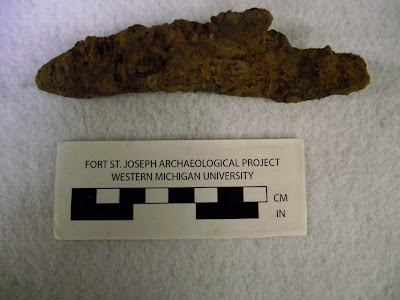Hello everyone! This is Anne again
and as I’m sure you all know, the 2016 field season has been quite eventful.
Although our main focus in excavating this season is to recover information
about the architecture of the fort, we have gained so much knowledge about
French culture and the importance of the St. Joseph River to the people of the
past. This previous semester at WMU, I took Dr. Nassaney’s class, Anthropology
in the Community, and my classmates and I created panels that contained
information about the fort in relation to the river. I was able to focus my
research on river resources and was very interested by the use of aquatic
plants and animals during the occupation of the fort (the panels will be
exhibited at the open house this weekend, so make sure to come see!).
 |
| Beaver femur found in my and Tommy's unit. (Photo credit By author) |
It just so happens that Dr. Terry
Martin, Curator Emeritus of the Illinois State Museum, has been able to spend
the past week with us! Terry has been a huge part of the project for several
years and actually helped my partner and I with information that we included on
our panel. As a faunal analyst, he studies animal remains and knows a great
deal about the creatures that lived amongst and were consumed by the French. We
attended his lecture this past Wednesday and he discussed river resources among
archaeological sites, including lake sturgeon. These fish are truly incredible,
and are even viewed as mythological creatures in certain native cultures.
Although they were once plentiful in the area, dams have prevented them from
accessing their normal spawning areas. Lake Sturgeon are potamodromous fish,
meaning that they will migrate, but only from fresh water lakes to rivers.
Often, small bones from their spine and skull will be recovered in the archaeological
record from sites near rivers. Fort St. Joseph however, has so far expressed an under-representation in fish bones overall.
 | |
| Maureen looking at the various animal bones. (Photo Credit: By author) |
To further our understanding of the
animals present at Fort St. Joseph, my fellow students and I were able to
analyze faunal remains with Terry. We looked at bone fragments that were
recovered this year and determined the type of bone found and which animal they
were from. I think that this knowledge will be really beneficial to us in the
field as we continue to come across animal remains! Speaking of which, my
partner Tommy and I came across a beaver tooth and femur these past couple of
weeks, which is evidence of the animal having been significant in the fur
trade.







